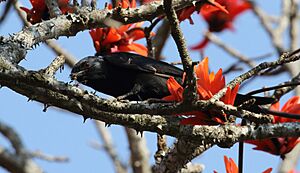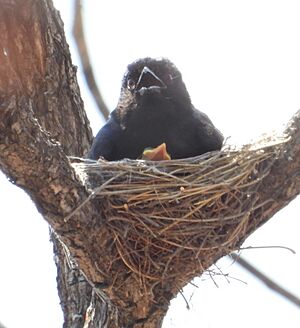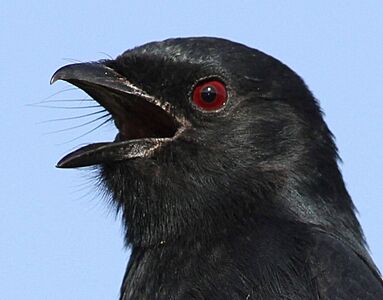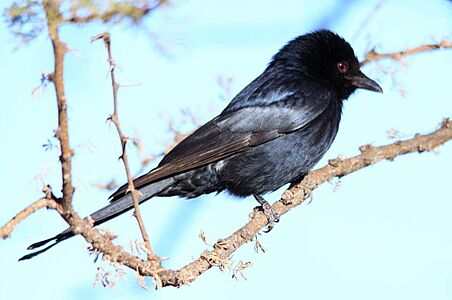Fork-tailed drongo facts for kids
Quick facts for kids Fork-tailed drongo |
|
|---|---|
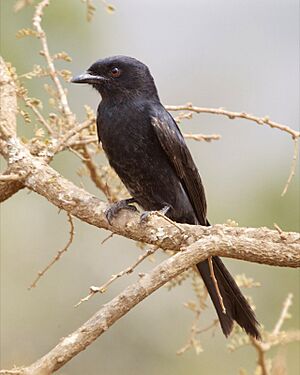 |
|
| Conservation status | |
| Scientific classification | |
| Genus: |
Dicrurus
|
| Species: |
adsimilis
|
The fork-tailed drongo (Dicrurus adsimilis), also known as the common drongo or African drongo, is a small bird. You can find it from the Sahel region all the way to South Africa. These birds love living in wooded areas, especially woodlands and savannas.
The fork-tailed drongo belongs to the family Dicruridae. It has a narrow, fork-shaped tail and reddish-brown eyes. Its feathers are completely black. Like other drongos, this bird mainly eats insects. Its favorite foods include butterflies, termites, and grasshoppers.
These birds build their nests near wetlands, forests, and farms. The time they lay eggs changes depending on the region. A female drongo usually lays one to four eggs. These eggs hatch in about 15 to 18 days.
The fork-tailed drongo is famous for its clever tricks. It can mimic the alarm calls of other birds. It does this to scare animals away so it can steal their food. Drongos are also very brave and aggressive. They will attack much larger animals, even birds of prey, to protect their nests. Because there are so many of them, the IUCN Red List says the fork-tailed drongo is a least-concern species. This means it is not in danger.
Contents
About the Fork-tailed Drongo
The fork-tailed drongo was first described by Johann Matthäus Bechstein in 1794. There are several different types, or "races," of this bird. These races live in different parts of Africa. For example, one type lives in Gabon and Angola. Another type lives in Uganda and Kenya. Each type might have small differences in size or feather color.
Where Drongos Live
The fork-tailed drongo is very common across Africa south of the Sahara desert. This bird loves open woodlands, savannas, and forest edges. It can even live in dry places. You can find these birds at high places, up to 2200 meters (about 7,200 feet) above sea level.
What Drongos Look Like
Adult drongos have a strong black beak and bright red eyes. Their whole body is black. When they are born, baby drongos have reddish skin and an orange beak. Young drongos are dark brown with some lighter feather tips. Their tail fork is not as deep as an adult's.
Both male and female drongos are black. Their upper body has a shiny blue-green color. Their long, deeply forked tail is black. It measures about 11.5 to 12.6 centimeters (4.5 to 5 inches) long. They have short legs and a wingspan of about 13.4 centimeters (5.3 inches).
After breeding, adult birds grow new feathers. This usually happens between December and March in Southern Africa. Young birds keep their young feathers until the next breeding season.
Drongo Sounds and Calls
These birds are very noisy! They often start singing at dawn and are the last to be heard at dusk. Their early morning calls sound like jwaaa-jwaaa and jeewy-jeeerr. They make many different sounds. These include sharp calls, short whistles, and squeaks. They also make smooth, raspy, or scratchy notes.
Drongos make their own special calls. But they also copy the sounds of other birds. They can mimic bocage's bushshrikes, thrushes, tchagras, bulbuls, birds of prey, and owls. They have even been heard copying the sounds of cats and the alarm calls of meerkats!
Drongo Behavior
How Drongos Find Food
Fork-tailed drongos mostly eat insects. Sometimes, they also eat small fish or other birds. They might even drink nectar from flowers or eat plants. Their main foods are butterflies, beetles, caterpillars, grasshoppers, honey bees, moths, and termites. They especially like desert locusts.
Sometimes, they catch small fish by diving from a branch over water. They have also been seen catching small birds with their claws or beaks. About 15% of their diet comes from plants. These birds hunt alone. They spend about 62% of their day looking for food during the dry season. In the rainy season, they spend about 56% of their day feeding.
Drongos usually sit on a branch about 5 to 7 meters (16 to 23 feet) high. From there, they quickly fly out to catch insects. They might grab them in the air, dive to catch them, or pick them up from the ground. Then, they fly back to the same branch. They can hold large insects with their claws and tear them apart with their beaks.
These birds often fly near savanna fires. They catch insects and other small animals trying to escape the flames. Drongos also follow large mammals like elephants and giraffes. As these big animals move, they stir up insects. The drongos then catch the insects. This is called a commensalist relationship.
Clever Food Stealing (Kleptoparasitism)
One clever way the fork-tailed drongo gets food is by stealing it from other animals. This is called kleptoparasitism. The drongo will sometimes make real alarm calls to warn other animals about predators. But sometimes, it will make a fake alarm call. This makes other animals run away, leaving their food behind for the drongo to steal! Drongos might also directly attack other animals to get their food.
Drongos spend about 29% of their time following other animals. They often target ground-feeding animals like southern pied babblers, sociable weavers, wattled starlings, and meerkats. Drongos steal food because they are not built to hunt some of the bigger, more nutritious prey themselves.
These birds often lead mixed-species foraging flocks. They act as lookouts for other species. This helps everyone stay safe from predators and find more food. At the same time, the drongo uses these groups to find more chances to steal food.
Scientists have wondered if drongos have a "theory of mind." This means they might understand what other animals are thinking. This is because drongos can change their tricks. They might make real or fake alarm calls depending on the situation. About a quarter of their food comes from stealing. The food they steal is usually bigger than what they catch on their own. After a fake alarm call, the drongo will often make an "all clear" signal. This helps the other animals go back to feeding. It also helps the drongo gain their trust back by making real alarm calls sometimes.
Some studies suggest that drongos might not rely on stealing food all the time. They might use this trick mostly when food is hard to find, like during droughts or on cold days. Even though stolen food is bigger, stealing can be risky. It might cost the drongo more energy than finding its own food.
Reproduction and Life Cycle
During the breeding season, drongos often build nests near wetlands, forests, and farms. These places offer good spots and materials for nesting. They usually have one partner for life. Drongos are very aggressive towards other drongos and animals that might harm their nests. This includes crows, birds of prey, hornbills, shrikes, small mammals, and large snakes. Mated pairs will sit together, sing duets, and nod their heads.
The breeding season is usually from March to September north of the equator. South of the equator, it's from September to January. The exact time they lay eggs changes a lot by region. They can have one to four groups of eggs. If they lose their eggs early, they might lay new ones.
Nests are usually built 2.2 to 17 meters (7 to 56 feet) above the ground. They are built between horizontal branches. The nests are shaped like a saucer. They are made from plant stems, lichens, small roots, tendrils, and cobwebs. Eggs are laid every 24 to 48 hours. The eggs hatch in 15 to 18 days. Both male and female drongos feed the chicks. They give them flies, beetle larvae, lizards, and seeds. The chicks stay in the nest for about 16 to 22 days.
Sometimes, African cuckoos lay their eggs in drongo nests. This is called Brood parasitism. Jacobin cuckoos also do this in the Kalahari Desert. Drongo eggs come in many colors and patterns. The cuckoos try to lay eggs that look similar. But drongos are good at spotting and rejecting eggs that are not theirs. They reject about 93.7% of eggs that are put into their nests.
Conservation Status
The fork-tailed drongo is considered a least-concern species by the IUCN Red List. This is because it lives in a very large area and its population is stable. However, one type of drongo, D. a. modestus, was once considered "near-threatened."
The fork-tailed drongo faces some dangers. Pesticides can reduce the number of insects they eat. Also, their habitat destruction can happen when farms expand. But this bird is not likely to be in danger soon. It actually benefits when dense forests are cleared, as it prefers more open areas.
Images for kids



